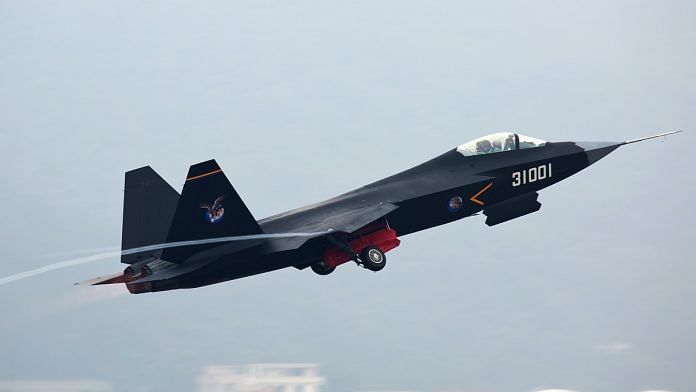New Delhi: Pakistan is in the process of acquiring Chinese-made J-31 stealth fighters, which are a copy of American F-35 and F-22 aircraft, in a move that could possibly alter the balance of air power in the region.
Once acquired, the new fighters could replace early versions of the American F-16 aircraft in Pakistan’s fleet, sources in the defence and security establishment told ThePrint.
Earlier this week, Pakistan-based media outlets quoted Pakistan Air Force (PAF) chief Air Chief Marshal Zaheer Ahmed Babar as saying that talks are ongoing with China in this regard. “The foundation for acquiring the J-31 stealth fighter aircraft has already been laid which is all set to become part of the PAF’s fleet in the near future,” he said.
The PAF is already operating two types of Chinese-made aircraft, one of which — JF-17 ‘Thunder’ — is being jointly manufactured in Pakistan and was also acquired by Nigeria in 2021. Besides the 150 odd JF-17s in its fleet, PAF also acquired 25 J-10C ‘Vigorous Dragon’ fighters in 2022 in what was seen as a counter to India’s acquisition of 36 French-made Rafale fighter jets.
The acquisition of the J-31, however, may come as a shot in the arm for Pakistan since India does not operate a stealth fighter. Though India is currently working on an indigenous stealth fighter, Advanced Medium Combat Aircraft (AMCA), it is unlikely to be inducted before 2030.
Air Marshal Anil Chopra (Retd), Director-General of IAF’s think tank Centre for Air Power Studies (CAPS), told ThePrint that the J-31 is still in the development stage, unlike the bigger stealth aircraft J-20 of which China has produced about 150 units.
The J-31, he said, is a smaller aircraft and mainly being looked at by China as the naval version that can be operated from aircraft carriers. “The J-31 is still not inducted into the Chinese air force. Let it be developed first,” he added.
Air Marshal Diptendu Choudhury (Retd) told ThePrint, “While the US may upgrade the F-16s to a limited point, the Pakistanis are unlikely to get any kind of next-generation (aircraft).”
The former fighter pilot noted that though issues have been reported with Chinese-made aircraft in the past, Beijing continues to push them out, unlike others who will come out with the best possible version, since it puts the US on the spot and also helps build an aura of superior Chinese aviation capabilities. Asked if the acquisition of J-31s could alter the balance of air power between India and Pakistan, he said, “Pakistan is thinking long term.”
“Unlike in the past, they (Pakistan) are not sure if help from the US will continue to be forthcoming. The dynamics do not really change to a large extent. Just getting one set of good fighters will not change (the power dynamics) but it definitely adds quality to their (PAF’s) air power. Quantity-wise, the ratio of newer generation jets matters,” he added.
By some estimates, about 60-70 percent of the fleet of the People’s Liberation Army Air Force is made up of 4th– and 5th-generation fighters. “This is exactly what the Indian Air Force is also trying to do. The process has to be sped up,” said Choudhury.
According to a report by Military-Today.com, China in 2007 managed to obtain blueprints of and other classified information on the F-35 Joint Strike Fighter and the F-22 Raptor.
Reports suggest the Shenyang Aircraft Corporation (SAC) relied on this data to develop the J-31 or FC-31 stealth aircraft. While earlier versions of the J-31 looked like near-clones of the F-35, pictures that surfaced later hint at a more elongated shape with larger tail surfaces — more suggestive of the F-22.
(Edited by Amrtansh Arora)
Also Read: India closer to new drone power as indigenous solar-powered pseudo-satellite flies for over 21 hrs






